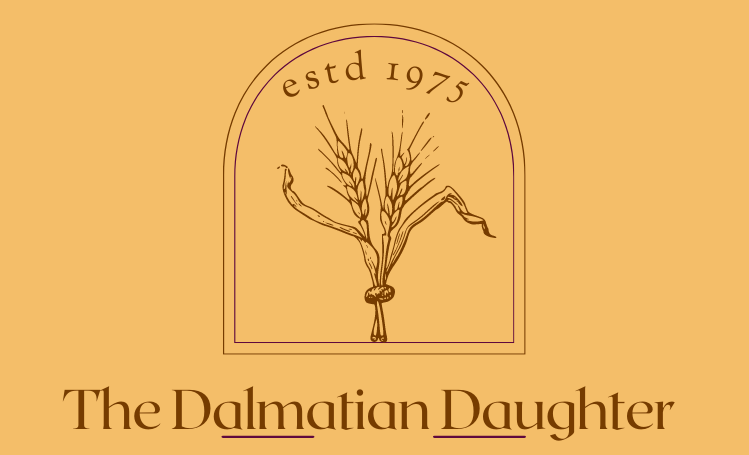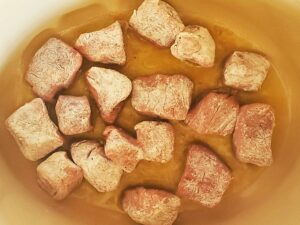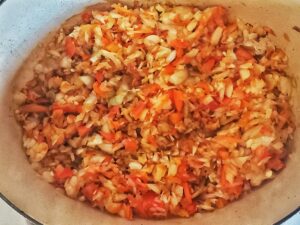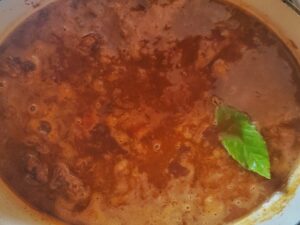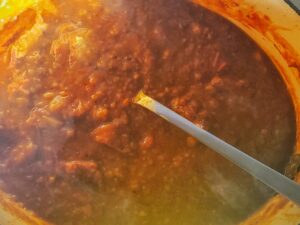Croatian Goulash
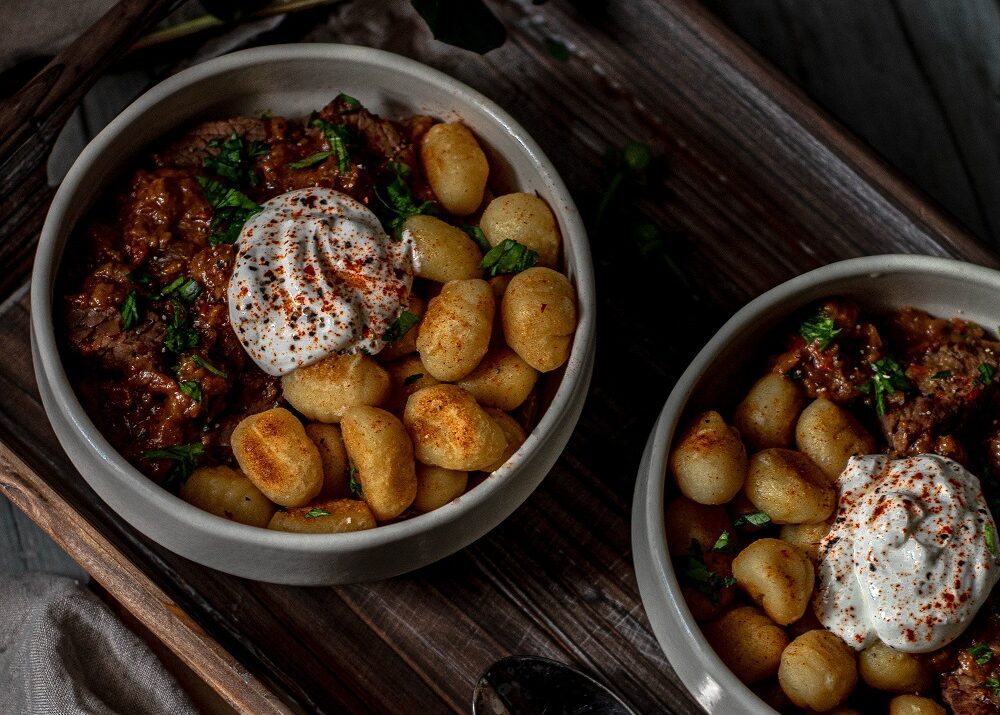
The pinnacle of comfort foods, this Croatian Goulash is savory and simple–braised beef cubes are combined with the holy trinity of Central European cooking: onion, pepper, garlic. The meat is braised in red wine and then slow cooked in beef broth until the most succulent stroganoff style goulash is achieved. Served up with egg noodles, gnocchi, or polenta, our Croatian Goulash will warm any belly on a chilly night.
Jump to RecipeFamily Recipe
I have written at length about making goulash. It’s all over the internet at this point (ok, not literally.)
Rather than spell it out again here, I can direct you to two places that have generously housed my literary musings about my family, loss, and Croatian Goulash.
The piece is called “A History of Goulash” and, while I was finally going after that long prized MFA in Creative Writing in Nonfiction at The New School, their food publication, The Inquisitive Eater, published the piece here.
Then, while simultaneously deep diving and running away from food writing online, I stumbled upon a delightful online publication called Porridge Magazine in the UK. They didn’t mind the re-print, and published A History of Goulash last year in their Comfort Foods publication.
I have made two Goulashes since the fall arrived. Each time my mind decides to make the treasured Croatian stew, I feel something that I rarely feel: a combination of memory, assuredness, and, well, comfort. It is an overused word, but the shape of this comfort is somewhere between the scent of the stew, a glass of red wine, a warm home in the autumn, and my father whom I miss. Any more than that, well, have a read above.
A History of Goulash
In addition to MY history of goulash, the history of the rich brown stew is a rather simple one. I have spoken many times about the Central European Austro Hungarian Empire’s influence on Croatian cooking and baking (thank God). It starts primitively as a soup/stew made over an open fire.
The presence of the Mongols, the Huns, and the Turks left fields of chili plants growing across the Central European plains, along with coffee thankfully. The pepper and its companion spices, paprika and red pepper flake, are the heat, the flavor, and heart of the dish. The meat and other ingredients are just the vehicles in motion. Hungarian versions often use mushrooms and cream, which you are most welcome to do; I prefer a secret ingredient spoken of below for thickening the goulash, and now follow the ways of my Turkish American guy, adding a little sour cream when serving.
When in Croatia, one of my favorite anti-heroes Anthony Bourdain found himself in front of a giant copper pot that had been cooking in the open air for hours upon hours. It was not a typical Goulash, but a popular Veal and Rice Stew called Cobanac. However, his host referred to it as a type of goulash, any stew cooked all day with love and care, and multiple glasses of wine.
Goulash is a culinary symbol of time well taken. No shortcuts, and none needed since the dish is so easy to prepare. 20 minutes in, you are off enjoying the rest of the bottle of red wine while the dish prepares itself for you–one moment, minute, and hour at a time.
Goulash Process
What I have come to know as my family’s Croatian Goulash is quite “Stroganoff-y”; a cheaper cut of cubed beef (you can use sirloin, but the meat is just not as tender as it could be) is rolled in flour and braised. The Mediterranean mirepoix of onion, pepper, and garlic are then sauteed in olive oil and deglazed with a healthy dose of red wine.
What follows is simply a little tomato paste, some beef broth, and spice: salt, black pepper, red pepper flakes, paprika of course, and a bay leaf. The meat is added back in and simmers for about 2 hours. An hour into the process, I follow my mother’s ritual of browning an undetermined amount of flour (let’s say, 1/4 cup?) and sifting it into the stew. It allows the end result to appear creamy and thickens it to a delectable consistency that only improves overnight.
As I talk about in my Goulash piece, I grew up on goulash served with egg noodles, extra wide. It is perfect unto itself, and tastes amazing cold. As I grew up, and visited my father’s family in Split, my suspicions of Goulash with Gnocchi were proven true, and so that was how I photographed the Goulash here.
Recently, I also took on the popular stew companion in Croatia and Italy: polenta. Made creamy. There is no wrong way. The Hungarians would certainly appreciate mashed or roast potatoes. Just leave your salads aside for this one. Carbs are necessary here (there, and everywhere).
Another interesting turn of events came when visiting friends in South Carolina. My best friend, mentioned in my History of Goulash, asks me to make it every time she and I are in the same place. This time, there were no beef cubes available for use, so we decided to buy a chuck roast with beautiful marbles of fat running their way through the meat, and cut it up by hand. I do believe it my favorite way of doing it now–avoids the lack of fat issue, and you can cut to your desired shapes and specifications.
Whether your family history, mine, or no one’s, this warm and inviting Croatian Goulash, tried, mastered, and repeated over more years than I care to remember, is yours. Create a new history, a new ritual, a new loving meal.
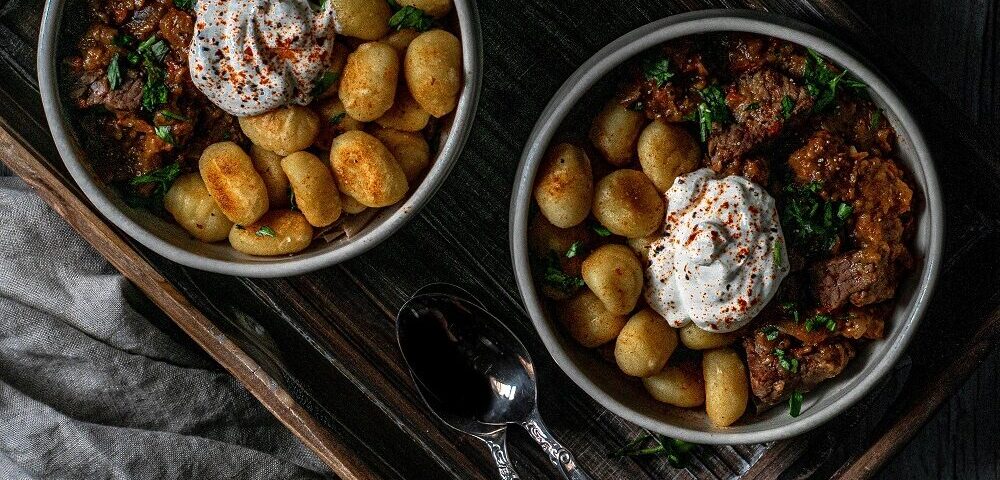
Croatian Goulash
Ingredients
- 2 – 2.5 lbs beef cubes, or cubed chuck roast (avoid sirloin)
- ½ cup all purpose flour
- 2 tbsp olive oil
- 2 medium onions, chopped
- 1 green pepper (red or other peppers all work)
- 2 cloves garlic, minced
- ¾ cup red wine
- 1 tbsp tomato paste
- 4 cups beef stock
- 1 tbsp paprika (Hungarian if possible)
- 1 tsp red pepper flakes
- salt and pepper to taste
- 1 bay leaf
- ¼ cup additional flour as a roux
Method
- Salt and pepper the beef cubes. Roll in flour.

-
- Add olive oil to pot over medium heat, and add a layer of the floured beef cubes. Brown for about 5 minutes a side until a nice crust has formed. Do not overcrowd and brown the cubes in batches. Let drain on paper towels.

-
- Add more olive oil to the pot and lower the heat to medium/low. Saute the onions, pepper, and garlic until translucent, for about 5-7 minutes.

-
- Turn up the heat to high and add the red wine. Scrape the bottom of the pot and any leftover flour or meat. Allow the alcohol to burn off and reduce for about 7-8 minutes.
- Lower the heat to medium again and add in the tomato paste and spices. Combine until fully incorporated and add in the beef stock. Turn up the heat again, and bring the meat back to the pot. Mix as it comes to a boil. Cover and allow to simmer on a nice low temperature for two hours if possible, or at minimum 1.5 hours.

-
- An hour in, brown the additional flour in a sauce pan over medium/low heat, mixing all the time. It will take about 5-10 minutes depending on your stove. Then, sift the flour into the goulash and mix completely.

-
- Once done, allow the goulash to come to room temperature. Refrigerate overnight for the best consistency and serve with egg noodles, Gnocchi, pasta, potatoes, polenta. You can't go wrong. Goulash freezes really well for weeks and can be resurrected with a new side dish and a little water to loosen it while being heated up.

-
